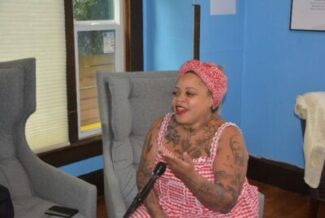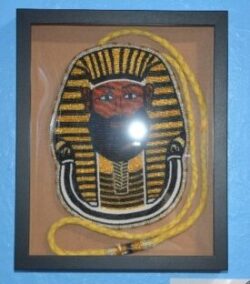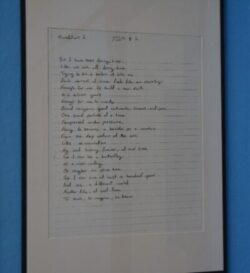“Voices from Inside”shines light on art by the Black Prisoners’Caucus
June 27, 2025 - 2:24 pm
On a leafy street in Seattle’s Central District, a two-story family home has welcomed visitors as a gallery space since 2019. Wa Na Wari, which means “our home” in the Nigerian language of Kalabari, is featuring art from the Black Prisoners’ Caucus from June 6th – July 13th, 2025. The center for Black art and belonging is showcasing beadwork, poetry, sketches, paintings, and video work centered on incarceration.
The Black Prisoners’ Caucus started in 1972 at the Monroe Correctional Complex when some men wanted access to better hygiene. They organized and advocated for better conditions. The prison system disbanded the group and sent the men to different facilities around Washington, but that only led to more organizing at more locations. Currently, there are 11 chapters inside facilities around the state.
Faraji Bhakti is Black Prisoners’ Caucus Community Wellness Director and a yoga instructor with Yoga Behind Bars. Bakhti says that art is a meaningful outlet for incarcerated people and can offer connection with the outside. “Me being a poet myself, the way that you can capture some of those moments of being incarcerated flows out poetically. Sometimes it’s …joyous when you have moments that you don’t feel like you’re incarcerated…being able to free your voice becomes medicine.”
 Elisheba Johnson is a co-founder of Wa Na Wari and curated the exhibit. She tried to choose works that would highlight the beauty of the art, but also educate visitors around the issue of incarceration. “I think all the artworks by the folks that are on the inside are beautiful and about joy and power and all of that. But I also, as a compliment, brought in artworks, videos by other artists, either talking about mass incarceration or the effects of mass incarceration and how America really makes money off of prisons and how slavery has just turned into, right, incarcerating folks, right? Like we didn’t lose that. It just morphed and changed.”
Elisheba Johnson is a co-founder of Wa Na Wari and curated the exhibit. She tried to choose works that would highlight the beauty of the art, but also educate visitors around the issue of incarceration. “I think all the artworks by the folks that are on the inside are beautiful and about joy and power and all of that. But I also, as a compliment, brought in artworks, videos by other artists, either talking about mass incarceration or the effects of mass incarceration and how America really makes money off of prisons and how slavery has just turned into, right, incarcerating folks, right? Like we didn’t lose that. It just morphed and changed.”
Inside the gallery, the walls are painted bright, sky blue. Intricate beadwork is mounted around the space including multi-colored earrings and larger pieces that could be worn or displayed.
 Johnson stood in front of one framed work depicting a pharaoh. “I’m looking at a beautiful beaded piece of what looks like a pharaoh, very, very detailed, and has a string there can be worn as like a necklace or hung. It’s got black and gold, and the Pharaoh is brown, unlike other depictions of Egyptian. So, yeah, it’s very beautiful.”
Johnson stood in front of one framed work depicting a pharaoh. “I’m looking at a beautiful beaded piece of what looks like a pharaoh, very, very detailed, and has a string there can be worn as like a necklace or hung. It’s got black and gold, and the Pharaoh is brown, unlike other depictions of Egyptian. So, yeah, it’s very beautiful.”
Moving around the space, Johnson describes a sketch of a woman dressed in purple with high boots. “She’s got some handcuffs, but she’s also got a halo, and she’s got a little mask that’s protecting her. It looks like from COVID. So she’s like a fairy, a black, beautiful fairy.”
Framed poetry covers several walls, some of it typed and some of it handwritten. The name of the poet is posted alongside the work and some pieces include a Department of Corrections number. Bakhti says that visitors can reach poets inside the system by looking up their number on the DOC web site, filling out a form, or sending a letter through the mail.
The video works in the exhibit expand the discussion on incarceration. One collaborative piece is a study of solitary confinement. The group of artists asked individuals in solitary confinement to put in requests for photos, real or imagined. The artists received a range of very detailed requests and moved forward with procuring the photos. The documentation of the requests and photos is a window into the thoughts and imagination of someone in solitary confinement.
 When Bhakti visited the exhibit and experienced the art, he described a visceral feeling of the time he spent incarcerated. “…it just brings back that it is imperative to honor humanity holistically whether the people are incarcerated or not, but more so for the people being dehumanized by the system.”
When Bhakti visited the exhibit and experienced the art, he described a visceral feeling of the time he spent incarcerated. “…it just brings back that it is imperative to honor humanity holistically whether the people are incarcerated or not, but more so for the people being dehumanized by the system.”
For more information about the exhibit, please visit the Wa Na Wari web site.

